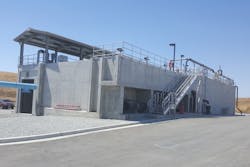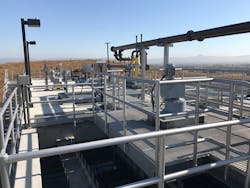A consortium including the city of Hollister, Calif., the San Benito County Water District and the Sunnyslope County Water District proposed the West Hills Water Treatment Plant (WHWTP) project to improve drinking water quality, improve water supply reliability, and balance regional water resources in the Hollister urban area (HUA). Historically, HUA relied primarily on local groundwater basins for meeting its drinking water demands. While this groundwater met all drinking water regulations, it is high in minerals and hardness that often resulted in scaling and the need for further conditioning. Along with other initiatives, the WHWTP project enables the San Benito district to meet these goals through increased surface water capacity from the San Luis and San Justo reservoirs.
With the additional surface water for its drinking water supply and the potential season variation from each reservoir, the WHWTP project also needed to meet additional drinking water regulations focused on the removal of disinfection byproduct (DBP) precursors.
The Solution
Following an intensive evaluation process that included a pilot and multiple rounds of onsite bench scale testing to establish the ideal treatment technologies, WHWTP consists of pre-oxidation, ballasted clarification, gravity filtration, and finished water disinfection and storage. Given the potential variability in the source water, onsite testing evaluated both surface water reservoirs to ensure that the chosen treatment technologies can meet all project goals. Kruger was selected to supply the Actiflo Carb ballasted clarification system as part of the 4.5-million-gal-per-day (mgd) initial capacity of WHWTP. The facility is designed for future expansion to 9.0 mgd.
Process Description
The Actiflo Carb system has been in operation since August of 2017 and combines the benefits of a high-rate ballasted clarification system along with the adsorptive properties of powder activated carbon (PAC). The physical-chemical aspect of the Actiflo technology is combined with a PAC reactor and PAC recirculation circuit that enhances the removal of natural organic matter (NOM) and reduces operating expense.
PAC is widely used in drinking water treatment and well known for its efficiency in the removal of NOM, which is often measured through surrogate parameters such as total organic carbon (TOC) and dissolved organic carbon. PAC is not selective and is efficient in its absorption and removal of taste, odor and pesticides. Recent studies have shown PAC to also be effective in the removal of pharmaceuticals, personal care products and endocrine-disrupting compounds.
[Visit Kruger's WWD Storefront]
For WHWTP, this process combination provided a highly efficient, compact system that can handle source and seasonal variations in influent water quality while maximizing NOM removal and ensuring the facility complies with water quality goals for DBP concentrations.
Results
WHWTP has been successful in improving water quality and balancing water resources within the region. The implementation of Actiflo Carb is a key part of the treatment train and ensures the facility is successful in removing the NOM precursors that lead to DBP formation. During the evaluation process, multiple iterations of onsite testing determined that an effluent TOC target of 1.2 mg/L was needed to meet DBP goals for both water sources. The process has proven to consistently meet these TOC targets and gives WHWTP operational flexibility to handle both source and seasonal variations in influent quality.

